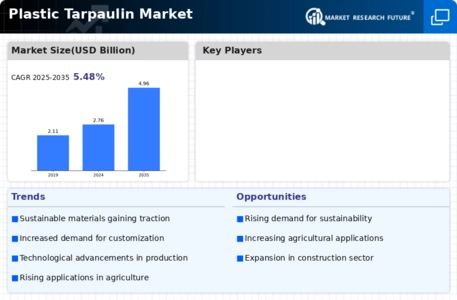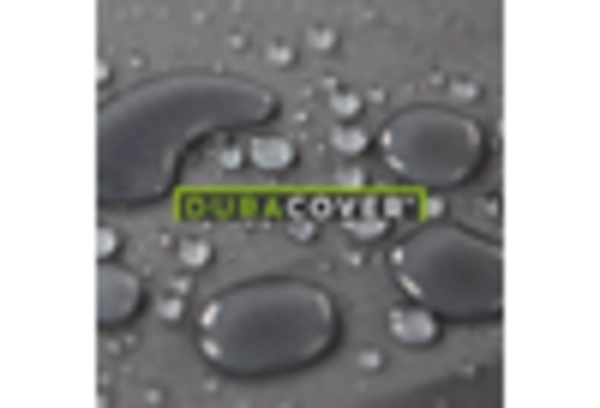Rising Demand in Agriculture
The increasing demand for agricultural products is a notable driver in the Plastic Tarpaulin Market. Farmers utilize plastic tarpaulins for various purposes, including crop protection, soil moisture retention, and as temporary storage solutions. The market for agricultural tarpaulins is projected to grow significantly, with estimates suggesting a compound annual growth rate of around 5% over the next few years. This growth is attributed to the need for efficient farming practices and the rising awareness of sustainable agriculture. As farmers seek to enhance productivity and protect their crops from adverse weather conditions, the adoption of plastic tarpaulins is likely to expand, thereby bolstering the overall market. The versatility of these tarpaulins in different agricultural settings further supports their increasing utilization.
Construction Sector Expansion
The ongoing expansion of the construction sector serves as a critical driver for the Plastic Tarpaulin Market. Tarpaulins are extensively used in construction for site protection, scaffolding, and as temporary enclosures. The construction industry has been experiencing robust growth, with investments in infrastructure development and residential projects on the rise. This trend is expected to continue, potentially leading to an increased demand for plastic tarpaulins. Market data indicates that the construction segment could account for a substantial share of the overall plastic tarpaulin market, with projections suggesting a growth rate of approximately 6% annually. As construction projects become more complex, the need for durable and weather-resistant materials like plastic tarpaulins is likely to escalate, further driving market growth.
Growth in Recreational Activities
The expansion of recreational activities and outdoor events is another notable driver for the Plastic Tarpaulin Market. Tarpaulins are widely used in various recreational settings, including camping, festivals, and sporting events, providing shelter and protection from the elements. The increasing popularity of outdoor activities has led to a surge in demand for durable and lightweight tarpaulins. Market data suggests that the recreational segment could witness a growth rate of around 4% annually, driven by the rising interest in outdoor leisure pursuits. As more individuals engage in camping and outdoor events, the need for reliable plastic tarpaulins is likely to grow, contributing positively to the overall market dynamics.
Innovations in Material Technology
Innovations in material technology are playing a pivotal role in shaping the Plastic Tarpaulin Market. Advances in polymer science have led to the development of more durable, lightweight, and environmentally friendly tarpaulins. Manufacturers are increasingly focusing on producing tarpaulins that offer enhanced UV resistance, tear strength, and waterproof capabilities. This trend is expected to attract a broader customer base, including industries such as agriculture, construction, and recreation. Industry expert's indicate that the introduction of innovative materials could lead to a potential market growth of 5% over the next few years. As consumers become more discerning about product quality and sustainability, the demand for technologically advanced plastic tarpaulins is likely to increase, thereby driving market expansion.
Increased Focus on Disaster Management
The heightened focus on disaster management and emergency preparedness is emerging as a significant driver in the Plastic Tarpaulin Market. Tarpaulins are essential in providing immediate shelter and protection during natural disasters such as floods, hurricanes, and earthquakes. Governments and humanitarian organizations are increasingly recognizing the importance of having adequate supplies of plastic tarpaulins for disaster relief efforts. Market analysis indicates that the demand for tarpaulins in emergency situations is likely to rise, with estimates suggesting a potential increase of 7% in the coming years. This trend reflects a growing awareness of the need for effective disaster response strategies, thereby enhancing the role of plastic tarpaulins in emergency management.


















Leave a Comment